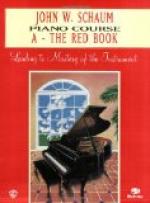The pianist who desires to play effectively, must continually strive for variety of tone, for tonal coloring. These can be studied in scales, chords, arpeggios and other technical forms. The singer seeks to make a tone of resonant color, not a straight, flat tone; the pianist, on his part, endeavors to give color and variety to his playing in the same way. Harold Bauer thinks variety must be secured by the contrast of one tone with another. Even a very harsh tone may be beautiful in its right place, owing to its relation to other tones, and its ability to express an idea. To render the playing expressive by the contrast of light and shade, by tonal gradations, by all varieties of touch, by all the subtleties of nuance, is a great art, and only the most gifted ever master it in its perfection. These are the things that enchant us in Paderewski’s performance, and in the tonal coloring of Gabrilowitsch. Hofmann’s playing is a marvel of atmosphere and color; such playing is an object lesson to students, a lesson in variety of light and shade, the shifting of exquisite tonal tints.
The sensitive musician is highly susceptible to color effects in nature, in art or in objects about him. Certain colors attract him, for he sees an affinity between them and the tonal effects he strives to produce. Other colors repel, perhaps for the opposite reason. Brilliant red is a warlike color, and finds analogous expression in such pieces as Chopin’s Polonaise Militaire, and MacDowell’s Polonaise. We cannot help seeing, feeling the color red, when playing such music. Soft pink and rose for love music, tender blues and shades of gray for nocturnes and night pieces are some of the affinities of tone and color. Warm shades of yellow and golden brown suggest an atmosphere of early autumn, while delicate or vivid greens give thoughts of spring and luscious summer. Certain pieces of Mozart seem to bring before us the rich greens of a summer landscape; the Fantaisie in C minor, and the Pastorale Varie are of this type.
Arthur Hochman says: “Colors mean so much to me; some are so beautiful, the various shades of red for instance, then the golden yellows, rich warm browns, and liquid blues. We can make as wonderful combinations in tone color as ever painter put upon canvas. To me dark red speaks of something tender, heart-searching, mysterious. On the other hand the shades of yellow express gaiety and brightness.”
It has been said that a pianist should study color effects in order to express them in his playing. He can do this to special advantage at the theater or opera, where he can see unrolled before him the greatest possible variety in light and shade, in colors, and in the constantly changing panorama of action and emotion.
The pianist can receive many ideas of tone color when listening to a great singer, and watching the infinite tonal gradations produced on the “greatest of all instruments,” the human voice.




